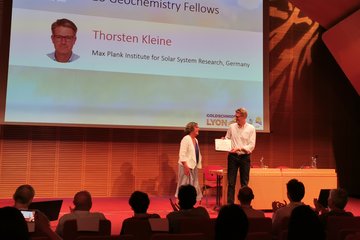Alle Typen
41.
Zeitschriftenartikel
An Automatic Detection Method for Extreme-ultraviolet Dimmings Associated with Small-scale Eruption. Astrophysical Journal 746, S. 12 - 19 (2012)
42.
Zeitschriftenartikel
Break up of returning plasma after the 7 June 2011 filament eruption by Rayleigh-Taylor instabilities. Astronomy and Astrophysics 540, L10 (2012)
43.
Zeitschriftenartikel
LEMUR: Large European module for solar Ultraviolet Research. European contribution to JAXA's Solar-C mission. Experimental Astronomy 34 (2), S. 273 - 309 (2012)
44.
Zeitschriftenartikel
Persistent Doppler Shift Oscillations Observed with Hinode/EIS in the Solar Corona: Spectroscopic Signatures of Alfvénic Waves and Recurring Upflows. Astrophysical Journal 759, 144 (2012)
45.
Zeitschriftenartikel
EUV Jets, Type III Radio Bursts and Sunspot Waves Investigated Using SDO/AIA Observations. Astronomy and Astrophysics 531, L13 (2011)
46.
Zeitschriftenartikel
Evolution of microflares associated with bright points in coronal holes and in quiet regions. Astronomy and Astrophysics 529, A21 (2011)
47.
Zeitschriftenartikel
Solar Particle Acceleration Radiation and Kinetics (SPARK). Experimental Astronomy 33, S. 237 - 269 (2011)
48.
Zeitschriftenartikel
Oscillations in the wake of a flare blast wave. Astronomy and Astrophysics 528, S. 12 - 15 (2011)
49.
Zeitschriftenartikel
STEREO quadrature observations of coronal dimming at the onset of mini-CMEs. Astronomy and Astrophysics 517, L7 (2010)
50.
Zeitschriftenartikel
STEREO observations of quasi-periodically driven high velocity outflows in polar plumes. Astronomy and Astrophysics 510, L2 (2010)
51.
Zeitschriftenartikel
Evidence of photospheric vortex flows at supergranular junctions observed by FG/SOT (Hinode). Astronomy and Astrophysics 493 (2), S. L13 - L16 (2009)
52.
Zeitschriftenartikel
Quiet Sun mini-coronal mass ejections activated by supergranular flows. Astronomy and Astrophysics 495, S. 319 (2009)
53.
Zeitschriftenartikel
A nanoflare model for active region radiance: application of artificial neural networks. Astronomy and Astrophysics 492, S. L13 - L16 (2008)
54.
Zeitschriftenartikel
SOHO/SUMER observations of prominence oscillation before eruption. Astronomy and Astrophysics 484, S. 487 - 493 (2008)
55.
Zeitschriftenartikel
SUMER-Hinode observations of microflares: excitation of molecular hydrogen. Astronomy and Astrophysics 481, S. L41 - L44 (2008)
56.
Zeitschriftenartikel
EIS/ Hinode Observations of Doppler Flow Seen through the 40-Arcsec Wide-Slit. Solar Physics 252, S. 283 - 292 (2008)
57.
Zeitschriftenartikel
Jets or High-Velocity Flows Revealed in High-Cadence Spectrometer and Imager Co-observations? Astrophysical Journal 670, S. L57 - L60 (2007)
58.
Zeitschriftenartikel
Determination of the coronal magnetic field from hot-loop oscillations observed by SUMER and SXT. Astrophysical Journal 656 (1), S. 598 - 609 (2007)
59.
Zeitschriftenartikel
Fe XIX observations of active region brightenings in the corona. Astronomy and Astrophysics 455, S. 1105 - 1113 (2006)
60.
Zeitschriftenartikel
Comparison of blinkers and explosive events: A case study. Astronomy and Astrophysics 432, S. 307 - 317 (2005)











